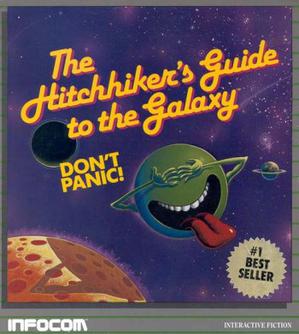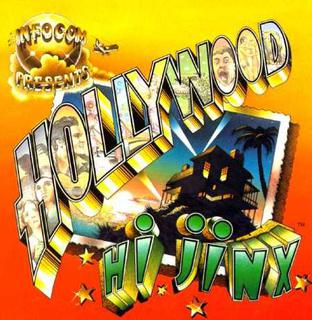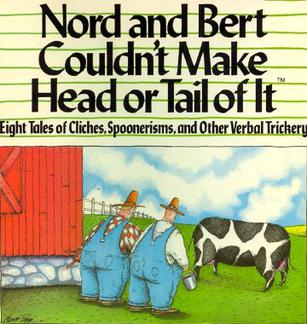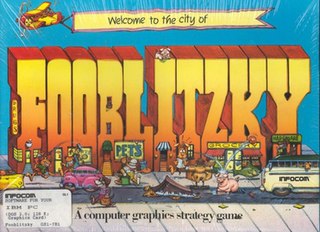Infocom was an American software company based in Cambridge, Massachusetts, that produced numerous works of interactive fiction. They also produced a business application, a relational database called Cornerstone.

Suspended: A Cryogenic Nightmare is an interactive fiction video game written by Michael Berlyn and published by Infocom in 1983. Infocom's sixth game, it was released for Amstrad CPC, Apple II, Atari 8-bit computers, Commodore 64, Commodore Plus/4, IBM PC compatibles, TRS-80, and TI-99/4A. It was later available for Mac, Amiga, and Atari ST.

The Hitchhiker's Guide to the Galaxy is an interactive fiction video game based on the comedic science fiction series of the same name. It was designed by series creator Douglas Adams and Infocom's Steve Meretzky, and it was first released in 1984 for the Apple II, Mac, Commodore 64, CP/M, MS-DOS, Amiga, Atari 8-bit computers, and Atari ST. It is Infocom's fourteenth game.
Magnetic Scrolls was a British video game developer active between 1984 and 1990. A pioneer of audiovisually elaborate text adventure games, it was one of the largest and most acclaimed interactive fiction developers of the 1980s, and one of the "Big Two" with Infocom according to some.

Leather Goddesses of Phobos is an interactive fiction video game written by Steve Meretzky and published by Infocom in 1986. It was released for the Amiga, Amstrad CPC, Amstrad PCW, Apple II, Mac, Atari 8-bit computers, Atari ST, Commodore 64, TI-99/4A, and MS-DOS. The game was Infocom's first "sex farce", including selectable gender and "naughtiness"—the latter ranging from "tame" to "lewd". It was one of five top-selling Infocom titles to be re-released in Solid Gold versions. It was Infocom's twenty-first game.

The Lost Treasures of Infocom is a 1991 compilation of 20 previously-released interactive fiction games developed by Infocom. It was published by Activision for MS-DOS, Macintosh, Amiga, and Apple IIGS versions. It was later re-released on CD-ROM, and in 2012 on iOS.

Starcross is an interactive fiction game written by Dave Lebling and published in 1982 by Infocom. The game was released for the IBM PC, Apple II, Atari 8-bit computers, Commodore 64, TRS-80, TI-99/4A, and later the Atari ST and Amiga. It was Infocom's fifth game and first in the science fiction genre. Starcross takes place in the year 2186, when the player's character is a lone black hole miner exploring an asteroid belt. It sold 90,315 copies.

Beyond Zork: The Coconut of Quendor is an interactive fiction video game written by Brian Moriarty and released by Infocom in 1987. It was one of the last games in the Zork series developed by Infocom. It signified a notable departure from the standard format of Infocom's earlier games which relied purely on text and puzzle-solving: among other features, Beyond Zork incorporated a crude on-screen map, the use of character statistics and levels, and RPG combat elements.

Spellbreaker is an interactive fiction video game written by Dave Lebling and published by Infocom in 1985, the third and final game in the "Enchanter Trilogy." It was released for the Amiga, Amstrad CPC, Apple II, Atari 8-bit computers, Atari ST, Commodore 64, Classic Mac OS, and MS-DOS. Infocom's nineteenth game, Spellbreaker is rated "Expert" difficulty.

Infidel is an interactive fiction video game published by Infocom in 1983. It was written and designed by Michael Berlyn and Patricia Fogleman, and was the first in the "Tales of Adventure" line. It was released for the Amstrad CPC, Apple II, Atari 8-bit computers, Commodore 64, IBM PC compatibles, TRS-80, and TI-99/4A. Ports were later published for Mac, Atari ST, and Amiga. Infidel is Infocom's tenth game.

Suspect is an interactive fiction video game designed by Dave Lebling and published by Infocom in 1984. It is the third and last murder mystery Infocom released. It was written in highly portable ZIL and released for Amiga, Amstrad CPC, Amstrad PCW, Apple II, Atari 8-bit computers, Atari ST, Commodore 64, Kaypro II, Mac, and MS-DOS. It is Infocom's fifteenth game.

Ballyhoo is an interactive fiction game designed by Jeff O'Neill and published by Infocom in 1985. The circus-themed game was released for ten systems, including MS-DOS, Atari ST, and Commodore 64. Ballyhoo was labeled as "Standard" difficulty. It is Infocom's nineteenth game.

Hollywood Hijinx is an interactive fiction video game written by Dave Anderson and Liz Cyr-Jones and published by Infocom in 1986. The game was released for the Apple II, Atari 8-bit computers, Atari ST, Amstrad CPC, Amstrad PCW, Commodore 64, Amiga, TI-99/4A, and MS-DOS. It was Infocom's twenty-third game.

Moonmist is an interactive fiction game written by Stu Galley and Jim Lawrence and published by Infocom in 1986. The game was released simultaneously for the Amiga, Amstrad CPC, Apple II, Atari 8-bit computers, Atari ST, Commodore 64, MS-DOS, TRS-80, TI-99/4A, and Mac. It is Infocom's twenty-second game. Moonmist was re-released in Infocom's 1995 compilation The Mystery Collection, as well as the 1996 compilation Classic Text Adventure Masterpieces.

Border Zone is an interactive fiction video game written by Marc Blank and published by Infocom in 1987. It was released for IBM PC compatibles, Apple II, Commodore 64, Amiga, Atari ST, and Mac. Border Zone incorporates real-time elements into the gameplay. It is also Infocom's thirtieth game. Its tagline is "Action and international intrigue behind the Iron Curtain."

Nord and Bert Couldn't Make Head or Tail of It is an interactive fiction video game written by Jeff O'Neill and published by Infocom in 1987. It was released simultaneously for Amiga, Apple II, Atari ST, Commodore 64, MS-DOS, and Mac. Nord and Bert is unique among Infocom games in that it presents wordplay puzzles. It was Infocom's twenty-seventh game.

Fooblitzky is a board game-style video game published by Infocom in 1985 and designed by a team which included interactive fiction authors Marc Blank and Michael Berlyn. It is unique among Infocom titles for not being interactive fiction and for being the first to incorporate graphics beyond ASCII characters. Unlike most Infocom games, it was only released for the Apple II, Atari 8-bit computers, and IBM PC compatibles.
Michael Berlyn was an American video game designer and writer. He was best known as an implementer at Infocom, part of the text adventure game design team. He is also known as the designer behind Bubsy in Claws Encounters of the Furred Kind (1993) and Bubsy 3D (1996).

The Guild of Thieves is an interactive fiction game by Magnetic Scrolls first published by Rainbird in 1987. The game takes place in Kerovnia, the setting of the company's earlier The Pawn.

Nine Princes in Amber is an interactive fiction video game with graphics. The game was published by Telarium, a subsidiary of Spinnaker Software, in 1985. The game is based upon the fantasy novels Nine Princes in Amber and The Guns of Avalon by Roger Zelazny.

















